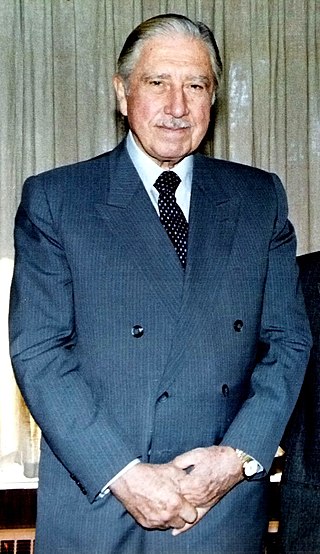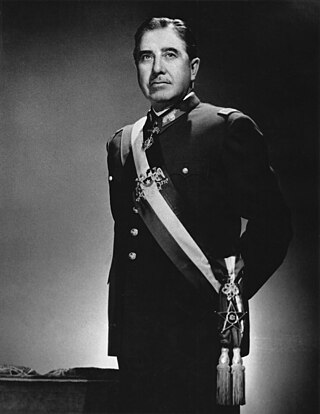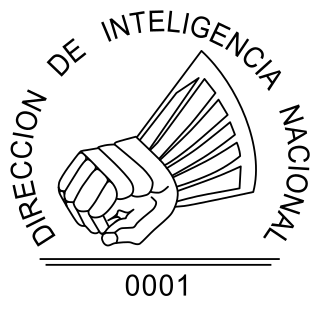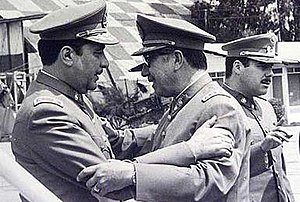
Charles Edmund Lazar Horman was an American journalist and documentary filmmaker. He was executed in Chile in the days following the 1973 Chilean coup d'état led by General Augusto Pinochet, which overthrew the socialist president Salvador Allende. Horman's death was the subject of the 1982 Costa-Gavras film Missing, in which he was portrayed by actor John Shea.

Carlos Prats González was a Chilean Army officer and politician. He served as a minister in Salvador Allende's government while Commander-in-chief of the Chilean Army. Immediately after General Augusto Pinochet's September 11, 1973 coup, Prats went into voluntary exile in Argentina. The following year, he and his wife, Sofía Cuthbert, were assassinated in Buenos Aires by a car bomb planted by the Dirección de Inteligencia Nacional.

The 1973 Chilean coup d'état was a military overthrow of the democratic socialist president of Chile Salvador Allende and his Popular Unity coalition government. Allende, who has been described as the first Marxist to be democratically elected president in a Latin American liberal democracy, faced significant social unrest, political tension with the opposition-controlled National Congress of Chile, and economic warfare ordered by United States president Richard Nixon. On 11 September 1973, a group of military officers, led by General Augusto Pinochet, seized power in a coup, ending civilian rule.
Michael Vernon Townley is an American-born former agent of the Dirección de Inteligencia Nacional (DINA), the secret police of Chile during the regime of Augusto Pinochet. In 1978, Townley pleaded guilty to the 1976 murders of Orlando Letelier, former Chilean ambassador to the United States, and Ronni Karpen Moffitt, Letelier's co-worker at the Institute for Policy Studies. He was sentenced to ten years in prison, serving 62 months. As part of his plea bargain, Townley received immunity from further prosecution; he was not extradited to Argentina to stand trial for the 1974 assassination of Chilean General Carlos Prats and his wife in Buenos Aires.
Zita Cabello-Barrueto is a Chilean-American academic and film-maker who successfully sued one of the perpetrators of the Caravan of Death for the murder of her brother, Winston Cabello Bravo, and torture of her husband, Patricio Barrueto, in 1973, following the overthrow of the Allende government.

General Augusto Pinochet was indicted for human rights violations committed in his native Chile by Spanish magistrate Baltasar Garzón in 1998. He was arrested in London six days later and held on house arrest for a year and a half before being released by the British government in 2000. Authorised to return to Chile, Pinochet was subsequently indicted by judge Juan Guzmán Tapia and charged with several crimes. He died in 2006 without having been convicted. His arrest in London made the front pages of newspapers worldwide; not only did it involve the head of the military dictatorship that ruled Chile between 1973 and 1990, it marked the first time judges had applied the principle of universal jurisdiction, declaring themselves competent to judge crimes committed in a country by former heads of state, despite the existence of local amnesty laws.

On 21 September 1976, Orlando Letelier, a leading opponent of Chilean dictator Augusto Pinochet, was assassinated by car bombing, in Washington, D.C. Letelier, who was living in exile in the United States, was killed along with his work colleague Ronni Karpen Moffitt, who was in the car with her husband Michael. The assassination was carried out by agents of the Chilean secret police (DINA), and was one among many carried out as part of Operation Condor. Declassified U.S. intelligence documents confirm that Pinochet directly ordered the killing.

On 11 March 1990, Chile the military regime of General Augusto Pinochet ended and was replaced by a democratically elected government. This transitional period lasted roughly two years although some processes may have lasted significantly longer. Unlike most democratic transitions led by either the elite or the people, this democratic transition process is known as an intermediate transition – a transition involving both the regime and the civil society. Throughout the transition, as the regime increased repressive violence, it simultaneously supported liberalization – progressively strengthening democratic institutions and gradually weakening that of the military.
Raúl Eduardo Iturriaga Neumann is a Chilean Army general and a former deputy director of the DINA, the Chilean secret police under the Augusto Pinochet military dictatorship. He was in charge of a secret detention center known as La Venda Sexy and La Discothèque—because of the sexual abuse inflicted on blindfolded prisoners as loud music masked their screams. An aide to General Manuel Contreras, head of the DINA, he was in charge of several assassinations carried out as part of Operation Condor. He has been condemned in absentia in Italy for the failed murder of Christian-Democrat Bernardo Leighton, and is wanted both in Spain and in Argentina. In the latter country, he is accused of the assassination of General Carlos Prats. He was later found to have played a prominent role in the assassination of Spanish-Chilean United Nations diplomat Carmelo Soria as well.
Eugenio Berríos Sagredo was a Chilean biochemist who worked for the Dirección de Inteligencia Nacional (DINA). Berríos was charged with carrying out Proyecto Andrea in which Pinochet ordered the production of sarin, a nerve agent used by the DINA. Sarin gas leaves no trace and victims' deaths closely mimic heart attacks. Other biochemical weapons produced by Berríos included anthrax and botulism. Berríos also allegedly produced cocaine for Pinochet, who then sold it to Europe and the United States. In the late 1970s, at the height of the Beagle Crisis between Chile and Argentina, Berríos is reported to have worked on a plan to poison the water supply of Buenos Aires. Wanted by the Chilean authorities for involvement in the Letelier case, he escaped to Uruguay in 1991, at the beginning of the Chilean transition to democracy, and what has been identified as his corpse was found in 1995 near Montevideo.
Carmelo Soria was a Spanish-Chilean United Nations diplomat. A member of the CEPAL in the 1970s, he was assassinated by Chile's DINA agents as a part of Operation Condor. Augusto Pinochet was later personally indicted over this case.
Gerardo Huber Olivares was a Chilean Army Colonel and agent of the DINA, Chile's intelligence agency. He was in charge of purchasing weapons abroad for the army. Huber was assassinated shortly before he was due to testify before Magistrate Hernán Correa de la Cerda in a case concerning the illegal export of weapons to the Croatian army. That enterprise involved 370 tons of weapons sold to the Croatian government by Chile on 7 December 1991, when Croatia was under a United Nations embargo arising from the war in Yugoslavia. In January 1992, Magistrate Correa sought testimony from Huber on the deal. However, Huber may well have been silenced to avoid implicating the Dictator, then-Commander-in-Chief of the Army Augusto Pinochet, who was himself awaiting trial on related charges.

Augusto José Ramón Pinochet Ugarte was a Chilean army officer and military dictator who ruled Chile from 1973 to 1990. He was the leader of the military junta from 1973 to 1981, and was declared President of the Republic by the junta in 1974 and thus became the dictator of Chile, and from 1981 to 1990 as de jure president after a new constitution which confirmed him in the office was approved by a referendum in 1980. His time in office remains the longest of any Chilean ruler.
Sergio Arredondo Gonzalez was a Chilean general who participated in the Caravan of Death in 1973 in Chile. He was the second in command to Sergio Arellano Stark who led the Caravan of Death. This death squad went out immediately following a successful coup and are said to be responsible for at least 75 deaths. The people who were executed were primarily non-hostile and already in custody, many were teachers, political organizers, or union leaders. After the Caravan tour of duty, he also was promoted, to the director of the Infantry School. He was later promoted to serve as Chile's military attache to Brazil as well.
Frank Teruggi, Jr. (1949–1973) was an American student, journalist, and member of the Industrial Workers of the World, from Chicago, Illinois, who became one of the victims of General Augusto Pinochet's military shortly after the September 11, 1973 Pinochet coup d'état against Socialist President Salvador Allende.

Human rights abuses in Chile under Augusto Pinochet were the crimes against humanity, persecution of opponents, political repression, and state terrorism committed by the Chilean Armed Forces, members of Carabineros de Chile and civil repressive agents members of a secret police, during the military dictatorship of Chile under General Augusto Pinochet from 1973 to 1990.

Sergio Arellano Stark was a Chilean military officer. He led the so-called "Caravan of Death," which killed 97 Chileans from helicopters and established Augusto Pinochet’s hold on power.

Project Andrea is the code name of an effort by the military dictatorship of Augusto Pinochet to manufacture sarin gas for use as a weapon against its opponents.

Carmen Hertz Cádiz is a Chilean Communist Party politician and lawyer who participated in various institutions for the protection of human rights that arose as a result of the systematic violations committed during the dictatorship headed by Augusto Pinochet from 1973 to 1990. She worked with the Vicariate of Solidarity, the Social Aid Foundation of Christian Churches (FASIC), the National Corporation for Reparation and Reconciliation, and the Ministry of the Interior's Human Rights Program. She became the human rights director of the Ministry of Foreign Affairs after Chile's transition to democracy, and was elected to the Chamber of Deputies in 2018.











